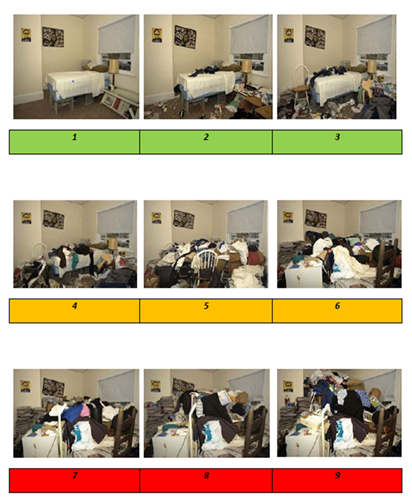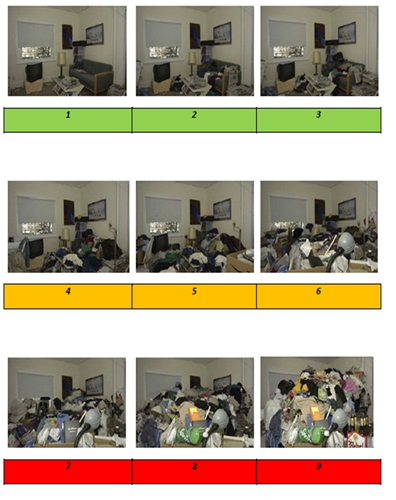Return to the contents
Appendix A: Clutter Image Rating Tool Guidance
Clutter Image Rating (CIR) – Bedroom
Please select the CIR which closely relates to the amount of clutter

Clutter Image Rating (CIR) – Lounge
Please select the CIR which closely relates to the amount of clutter

Clutter Image Rating (CIR) – Kitchen
Please select the CIR which closely relates to the amount of clutter

Return to the contents
Assessment guidance
Low Risk (green) - Criteria scale 1 to 3
- All Doors, Stairways and windows accessible
- No evidence of pests
- Clutter obstructs some functions of key living area – Looks untidy
- Safe Maintained sanitation conditions
Medium Risk (Amber) - Criteria scale 4 to 6
- Blocking of Doors, some windows, possibly major exit
- Light infestation of pests (e.g. bed bugs, lice, fleas, rats)
- Clutter obstructing functions of key living space, stairs, entrances, hallways etc.
- Evidence of non-maintained sanitation conditions (e.g. food preparation surfaces heavily soiled, lots of dirty dishes, obvious odours which irritate etc.)
- Evidence of burns to the carpet, clothing etc.
High Risk (Red) - Criteria scale 7 to 9
- Whole rooms inaccessible, exits blocked, windows not able to be opened
- Utilities cut off (e.g. no heating, gas capped)
- Heavy infestation of pests (rats seen, heard, reported by neighbours, cockroaches fleas etc.)
- Key living spaces not available for use, person living in one room
- Evidence of urine / excrement in room, rotting food, very insanitary conditions
- Evidence of previous fire or burns in the carpet, clothing etc.
Return to the contents
Guidance for practitioners
Listed below are examples of questions you may wish to ask where you are concerned about someone’s safety in their own home, where you suspect a risk of self-neglect and / or hoarding.
Most clients with a hoarding problem may be embarrassed about their surroundings so try to ascertain information whilst being as sensitive as possible.
- How do you get in and out of your property?
- Do you feel safe living here?
- Have you ever had an accident, slipped, tripped up or fallen? How did it happen?
- How do you move safely around your home? (Where floor is uneven or covered or there are exposed wires, damp, rot or other hazards)
- Has a fire ever started by accident? Is the property at risk from fire?
- Is there hot water, lighting and heating in the property? Do these services work properly?
- Do you have any problems keeping your home warm?
- When did you last go out in the garden? Do you feel safe to go outside?
- Are you able to use the bathroom and toilet ok? Have a wash, bath, shower etc.?
- Where do you sleep?
- Are there any obvious major repairs that need carrying out at the property?
- Are you happy for us to share your information with other professionals who may be able to help you?
Level One Indicators
| Level 1 Clutter image rating 1 - 3 |
Household environment is considered standard. No specialised assistance is needed. If the resident would like some assistance with general housework or feels they are declining towards a higher clutter scale, appropriate referrals can be made subject to age and circumstances. |
| 1. Property structure, services and garden area |
- All entrances and exits, stairways, roof space and windows accessible.
- Smoke alarms fitted and functional or referrals made to West Yorkshire Fire and Rescue Service to visit and install if criteria met.
- All services functional and maintained in good working order.
- Garden is accessible, tidy and maintained
|
| 2. Household Functions |
- No excessive clutter, all rooms can be safely used for their intended purpose.
- All rooms are rated 0-3 on the Clutter Rating Scale.
- No additional unused household appliances appear in unusual locations around the property.
- Property is maintained within terms of any lease or tenancy agreements where appropriate.
- Property is not at risk of action by Housing Standards Team.
|
| 3. Health and Safety |
- Property is clean with no odours, (pet or other).
- No rotting food.
- No concerning use of candles.
- No concern over flies.
- Residents managing personal care.
- No writing on the walls.
- Quantities of medication are within appropriate limits, in date and stored appropriately.
|
| 4. Safeguard of Children and Family members |
- No concerns for household members.
|
Level One: Multi-Agency Actions
| Level 1 |
Actions |
|
Identifying Agency
|
- Discuss concerns with the Individual.
- Raise a request to West Yorkshire Fire and Rescue Service for a Safe and Well visit and to provide fire safety advice.
- Refer to Adult Services Access point for guidance.
- Refer to GP if appropriate.
|
|
Housing Standards Team
|
|
|
Social Landlords
|
- Refer to GP if appropriate.
- Refer to Adult Services Access Point for assessment if appropriate.
- Provide details of support streams open to the resident via charities and self-help groups.
- Ensure residents are maintaining all tenancy conditions.
- Refer for tenancy support if appropriate.
- Ensure that all utilities are maintained and serviceable.
|
|
Practitioners
|
- Make appropriate referrals for support to other agencies.
- Refer to social landlord if the client is their tenant or leaseholder.
|
|
Emergency Services
|
- West Yorkshire Fire and Rescue Service - Carry out a Safe and Well visit if it fulfils
Service criteria and share with statutory agencies.
- West Yorkshire Police and Ambulance Service - Ensure information is shared with statutory agencies and feedback provided to referring agency on completion of home visits.
|
|
Safeguarding of Adults and Children
|
- Properties with adults or children presenting care and support needs should be referred to the appropriate Social Care referral point.
|
Level Two Indicators
| Level 2 Clutter image rating 4 - 6 |
Household environment requires professional assistance to resolve the clutter and the maintenance issues in the property. |
|
1. Property structure, services and garden area
|
- Only major exit is blocked.
- Concern that services are not well maintained.
- Smoke alarms are not installed or not functioning.
- Garden is not accessible due to clutter, or is not maintained
- Evidence of indoor items stored outside.
- Evidence of light structural damage including damp.
- Interior doors missing or blocked open.
|
|
2. Household Functions
|
- Clutter is causing congestion in the living spaces and is impacting on the use of the rooms for their intended purpose.
- Clutter is causing congestion between the rooms and entrances.
- Room(s) score between 4 - 5 on the clutter scale.
- Inconsistent levels of housekeeping throughout the property.
- Some household appliances are not functioning properly and there may be additional units in unusual places.
- Property is not maintained within terms of lease or tenancy agreement where applicable.
- Evidence of outdoor items being stored inside
|
|
3. Health and Safety
|
- Kitchen and bathroom are difficult to utilise and access.
- Offensive odour in the property.
- Resident is not maintaining safe cooking environment.
- Some concern with the quantity of medication, or its storage or expiry dates.
- Has good fire safety awareness with little or no risk of ignition.
- Resident trying to manage personal care but struggling.
- No risk to the structure of the property.
|
|
4. Safeguard of Children and Family members
|
- Hoarding on clutter scale 4 - 7. Consider a Safeguarding Assessment.
- Properties with adults presenting care and support needs should be referred to GWTC Please note all additional concerns for
householders.
|
|
5. Personal Protective Equipment (PPE)
|
- Latex Gloves, boots or needle stick safe shoes, face mask, hand sanitizer, insect
repellent.
- Is PPE required?
|
Level Two: Multi-Agency Actions
| Level 2 |
Actions
In addition to actions listed below these cases need to be monitored regularly in the future due to risk of escalation or reoccurrence |
|
Referring Agency
A referral to the Hoarding panel must be made in
cases where hoarding is rated at 5 or above on the Clutter Rating Image Scale
|
- Refer to landlord if resident is a tenant.
- Refer to Housing Standards Team if resident is a owner occupier.
- Raise a request to the Fire and Rescue Service to provide a Safe and Well visit with a consideration for monitored smoke alarms and / or assistive technology.
- Provide details of garden services.
- Refer to Adult Services Access Point for assessment.
- Referral to GP.
- Referral to debt advice if appropriate.
- Refer to animal welfare if there are animals at the property.
- Ensure information sharing with all necessary statutory agencies.
|
|
Housing Standards Team
|
- Referral to Housing Standards team if owner occupier wanting to clear or issues to neighbouring property i.e. pests
- Joint inspection with Environmental Health Officer.
- Consider serving notices under Public Health Act 1936, Environmental Protection Act 1990, Prevention of Damage by Pests Act 1949 or Housing Act 2004.
|
|
Social Landlords
|
- Visit resident to inspect the property & assess support needs.
- Refer internally to assist in the restoration of services to the property where appropriate.
- Ensure residents are maintaining all tenancy conditions.
- Enforce tenancy conditions relating to residents responsibilities.
- Ensure information sharing with all necessary statutory agencies.
|
|
Practitioners
|
- Carry out an assessment of the property practitioners assessment tool
- Ensure information sharing with all agencies involved to ensure a collaborative approach and a sustainable resolution.
|
|
Emergency Services
|
- West Yorkshire Fire and Rescue Service -
Carry out a Safe and Well visit, share risk information with Statutory agencies and consider assistive technology.
- West Yorkshire Police and Ambulance Service - Ensure information is shared with statutory agencies and feedback is provided to referring agency on completion of home visits via the referral form.
|
|
Animal Welfare
|
- Referral to RSPCA and / or provide advice or assistance with re-homing animals.
|
|
Safeguarding of Adults and Children
|
- Properties with adults or children presenting care and support needs should be referred to the appropriate Social Care referral point.
|
Level Three Indicators
| Level 3 Clutter image rating 7 - 9 |
Household environment will require intervention with a collaborative multi-agency approach with the involvement from a wide range of professionals. This level of hoarding constitutes a significant risk to the health of the householders, surrounding properties and residents.
Residents are often unaware of the implication of their hoarding actions and oblivious to the risk it poses. |
|
1. Property structure, services and garden area
|
- Limited access to the property due to extreme clutter.
- Extreme clutter may be seen at windows.
- Extreme clutter may be seen outside the property.
- Garden not accessible and extensively overgrown.
- Services not connected or not functioning properly.
- Smoke alarms not fitted or not functioning.
- Property lacks ventilation due to clutter
- Evidence of structural damage or outstanding repairs including damp.
- Interior doors missing or blocked open.
- Evidence of indoor items stored outside.
|
|
2. Household Functions
|
- Clutter is obstructing the living spaces and is preventing the use of the rooms for their
intended purpose.
- Room(s) scores 7 - 9 on the clutter image scale. Rooms are not used for intended purposes or very limited.
- Beds inaccessible or unusable due to clutter or infestation.
- Entrances, hallways and stairs blocked or difficult to pass.
- Toilets, sinks not functioning or not in use.
- Resident at risk due to living environment.
- Household appliances are not functioning or inaccessible.
- Resident has no safe cooking environment.
- Resident is using candles.
- Evidence of outdoor clutter being stored indoors.
- No evidence of housekeeping being undertaken.
- Broken household items not discarded e.g. broken glass or plates.
- Property is not maintained within terms of lease or tenancy agreement where applicable.
- Property is at risk of notice being served by Housing Standards Team.
|
|
3. Health and Safety
|
- Human urine and excrement may be present.
- Excessive odour in the property may also be evident from the outside.
- Rotting food may be present.
- Evidence may be seen of unclean, unused and or buried plates & dishes.
- Broken household items not discarded e.g. broken glass or plates.
- Inappropriate quantities or storage of medication.
- Pungent odour can be smelt inside the property and possibly from outside.
- Concern with the integrity of the electrics.
- Inappropriate use of electrical extension cords or evidence of unqualified work to the electrics.
- Concern for declining mental health.
|
|
4.Safeguard of Children and Family members
|
- Properties with adults presenting care and support needs should be referred to Adult Services Access Point.
- Please note all additional concerns for householders.
|
|
5. Animals and Pests
|
- Animals at the property at risk due the level of clutter in the property.
- Resident may not able to control the animals at the property.
- Animals’ living area is not maintained and smells.
- Animals appear to be under nourished or over fed.
- Hoarding of animals at the property.
- Heavy insect infestation (bed bugs, lice, fleas, cockroaches, ants, silverfish, etc.).
- Visible rodent infestation.
|
|
6. Personal Protective Equipment (PPE)
|
- Latex Gloves, boots or needle stick safe shoes, face mask, hand sanitizer, insect repellent.
- Visit in pairs required.
|
Level Three: Multi-Agency Actions
| Level 3 |
Actions |
|
Referring Agency
A referral to the Hoarding panel must be made in
cases where hoarding is rated at 5 or above on the
Clutter Rating Image Scale.
|
- If the individual does not meet the Safeguarding thresholds for a referral, consider contacting Social Care regarding
possible care and support needs assessment.
- Raise a request to West Yorkshire Fire and Rescue Service within 24 hours to provide a Safe and Well visit.
- Refer to Housing Standards Team by emailing [email protected] using the referral form.
|
|
Housing Standards Team
|
- Referral to Housing Standards team if owner occupier wanting to clear or issues to neighbouring property i.e. pests
- Joint inspection with Environmental Health Officer.
- Consider serving notices under Public Health Act 1936, Environmental Protection Act 1990, Prevention of Damage by Pests Act 1949 or Housing Act 2004.
|
|
Landlords
|
- Visit resident to inspect the property and assess support needs.
- Attend multi agency hoarding meeting.
- Enforce tenancy conditions relating to residents responsibilities.
|
|
Practitioners
|
- Refer to “Hoarding Guidance Questions for practitioners”.
- Complete Hoarding referral form
- Ensure information sharing with all agencies involved to ensure a collaborative approach and a sustainable resolution.
- West Yorkshire Fire and Rescue Service- Carry out a Safe and Well visit.
- Attend hoarding multi agency meetings on request.
- Ensure information sharing with all agencies involved to ensure a collaborative approach and a sustainable resolution.
- Provide feedback to referring agency on completion of home visits.
|
|
Animal Welfare
|
- Refer to RSPCA and / or educate client regarding animal welfare if appropriate.
|
|
Safeguarding of Adults and Children
|
- Properties with adults and / or children presenting care and support needs should be referred to the appropriate Social Care referral point.
|
Return to the contents
Appendix B: Websites for further reading
Cloud’s End CIC
Resources to help hoarders and housing associations dealing with hoarding
Hoarding Support
Information support and advice for hoarders and their families. Including and an online support forum.
OCD UK
Information and support about Obsessive Compulsive Disorder, which includes hoarding.
Hoarding UK
Information and support for hoarders and agencies, including local support groups
The Association of Professional De-Clutterers and Organisers (UK)<
Provide support, networking and promotion for members of the Professional Organizing and Decluttering industry, and information and services for their clients
Support Services.
Mind
Return to the contents
Bradford Multi agency Hoarding Framework
Return to main framework page



